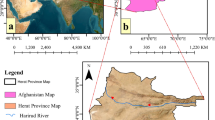Abstract
This paper addresses the influence of climate change on flood occurrence within the Veternica river stream, a tributary of the Južna Morava River. Depth-Duration-Frequency (DDF) curves serve as the indicators of climate change impacts. The Generalized Extreme Value (GEV) distribution is selected as the theoretical distribution function, and the Modified Method proposed by the Indian Meteorological Department (MIMD method) is employed to downscale daily precipitation data to sub-daily levels. DDF curves are established using both the standard and Koutsoyiannis’ methods, respectively. In addition, the HEC-HMS model will be utilized for the computation of flood hydrographs, and a comparative analysis will subsequently be carried out. Under climate change conditions, the hydro-graph peak for a 100-year return period, based on the standard method, exhibits variation ranging from a decrease of 17% to an increase of 2% compared to the reference period. However, the peak based on Koutsoyiannis’ method shows variation from a decrease of 4% to an increase of 12%, thereby indicating it as a more conservative approach.
Access this chapter
Tax calculation will be finalised at checkout
Purchases are for personal use only
Similar content being viewed by others
References
IPCC Homepage. https://www.ipcc.ch. Accessed 15 May 2023
Stojković, M., Plavšić, J., Prohaska, S.: Annual and seasonal discharge prediction in the middle Danube River basin based on a modified TIPS (Tendency, Intermittency, Periodicity, Stochasticity) methodology. J. Hydrol. Hydromech. 62(2), 165–174 (2017)
Solaiman, T., Simonović, S.: Development of Probability Based Intensity-Duration-Frequency Curves under ClimateChange. Department of Civil and Environmental Engineering, The University of Western Ontario, Canada, Report No: 072, 1913-3219 (2011)
Simonović, S.: Bringing future climatic change into water resources management practice today. Water Resour. Manage 31, 2933–2950 (2017)
Koutsoyiannis, D., et al.: A mathematical framework for studying rainfall intensity-duration-frequency relationships. J. Hydrol. 206, 118–135 (1998)
Mauriño, M.: Generalized rainfall-duration-frequency relationships: applicability in different climatic regions of Argentina. J. Hydrol. Eng. 9, 269–274 (2004)
AlHassoun, S.: Developing an empirical formulae to estimate rainfall intensity in Riyadh region. J. King Saud Univ. Eng. Sci. 23, 81–88 (2011)
Kawara, A., Elsebaie, I.: Development of rainfall intensity, duration and frequency relationship on a daily and sub-daily basis (case study: Yalamlam Area, Saudi Arabia). Water 14, 897 (2022)
Wheater, H., Larentis, P., Hamilton, G.: Design rainfall characteristics for south-west Saudi Arabia. Proc. Inst. Civil Eng. Part 87, Part 2, 517–538 (1989)
Galoie, M., et al.: Converting daily rainfall data to sub‑daily—introducing the MIMD method. Water Resour. Manage. 35, 3861–3871 (2021)
Copernicus EU-DEM v1.1. https://land.copernicus.eu/imagery-in-situ/eu-dem/eu-dem-v1.1. Accessed 19 May 2023
Copernicus CORINE Land Cover. https://land.copernicus.eu/pan-european/corine-land-cover. Accessed 19 May 2023
Climate Information Homepage. https://climateinformation.org. Accessed 19 May 2023
Silva, D., et al.: Introducing non-stationarity into the development of intensity-duration-frequency curves under a changing climate. Water 13, 1008 (2021)
Scielo. https://shorturl.at/acGH5. Accessed 30 May 2023
Silva, D., Simonović, S.: Development of nonstationary rainfall Intensity Duration Frequency curves for future Climate conditions. Department of Civil and Environmental Engineering, The University of Western Ontario, Canada, Report No: 106, (2020)
Markiewicz, I.: Depth–duration–frequency relationship model of extreme precipitation in flood risk assessment in the upper Vistula basin. Water 13, 3439 (2021)
Millington, N., Das, S., Simonović, S.: The Comparison of GEV, Log-Pearson Type 3 and Gumbel Distributions in the Upper Thames River Watershed under Global Climate Models. Department of Civil and Environmental Engineering, The University of Western Ontario, Canada, Report No: 077, 1913-3219 (2011)
Plavšić, J., et al.: Konsistentno određivanje racunskih kiša [Consistent assessment of computational rainfall]. Vodoprivreda 4, 151–159 (2015)
Acknowledgment
This research is supported by the Science Fund of the Republic of Serbia, Grant No. 6707, REmote WAter Quality monitoRing and INtelliGence, REWARDING.
Author information
Authors and Affiliations
Corresponding author
Editor information
Editors and Affiliations
Rights and permissions
Copyright information
© 2024 The Author(s), under exclusive license to Springer Nature Switzerland AG
About this paper
Cite this paper
Vinokić, L., Stojković, M., Kolaković, S. (2024). Statistical Method for the Depth-Duration-Frequency Curves Estimation Under Changing Climate: Case Study of the Južna Morava River (Serbia). In: Trajanovic, M., Filipovic, N., Zdravkovic, M. (eds) Disruptive Information Technologies for a Smart Society. ICIST 2023. Lecture Notes in Networks and Systems, vol 872. Springer, Cham. https://doi.org/10.1007/978-3-031-50755-7_24
Download citation
DOI: https://doi.org/10.1007/978-3-031-50755-7_24
Published:
Publisher Name: Springer, Cham
Print ISBN: 978-3-031-50754-0
Online ISBN: 978-3-031-50755-7
eBook Packages: Intelligent Technologies and RoboticsIntelligent Technologies and Robotics (R0)




